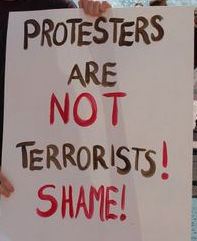|
The International Journal of Intelligence and Counterintelligence is a “medium for professionals and scholars to exchange opinions on issues and challenges encountered by both the government and business institutions in making contemporary intelligence-related decisions and policy.”
First published in January 1986, the journal covers a wide variety of topics, from factual information such as “The Exorbitant Cost of Counterterrorism” to the weightier dilemmas, like “To Render or Intern: Counterterrorism Methods of the FBI, SIS and CIA.”
The March 2013 edition featured an article entitled, “Subversion of Social Movements by Adversarial Agents,” written by Eric L. Nelson. Nelson’s profile provided with the article says he is a former counterintelligence agent with a U.S. Government and former police officer “in one of America’s most violent cities.” He has three master’s degrees and was completing his “individualized” Ph.D. in Criminology and Criminal Justice at the University of California when he wrote the paper.
Nelson outlines “thirteen suppressive or subversive methods” to bring about “social movement failure.” Failures are classified as either “petit” or “complete,” depending on whether the targeted movement or organization is merely demoralized and shaken up, or completely “brought down.”
The article begins with the author’s definition of “social movements,” characterized as “shar(ing) a desire for structural change, and a willingness to do something about it.” Examples are given: Iron Workers picketing a non-union construction site; people in Spain protesting against banks and austerity; Ukrainian FEMEN activists protesting sulfuric acid attacks on women while visiting Turkey. Social movements, he explains, can include “matters of politics, religion, ethnicity, labor, economy, and justice, among others.”
 The purpose of his article, is “to examine the intentional subversion of social movements by agents of the organization upon which the social movement is trying to force change.” Such organizations are both governmental and private companies targeted for “protest, boycotts, cyber attacks, or other harmful actions.” The purpose of his article, is “to examine the intentional subversion of social movements by agents of the organization upon which the social movement is trying to force change.” Such organizations are both governmental and private companies targeted for “protest, boycotts, cyber attacks, or other harmful actions.”
The article prefaces the subversion methods with an explanatory note: “Not all social movements need urgent attention, or vigorous suppression. Some are less threatening, and may be targeted for subversion using less drastic methods. Thus, the potential subversive actions range from nugatory to substantial. Most can be operationalized either covertly or in the open.”
The methods, each of them explained and illustrated, are: 1) Suppress Information Flow; 2) Suppress Recruiting Efforts; 3) Reduce Recruiting Opportunities 4) Develop Attractive Alternatives; 5) Tempt Members to Leave; 6) Reverse Recruiting Using Demoralizing Information; 7) Operationalize Secure/Faux Concessions; 8) Expertly Directed, Incessant Proactive Manipulation of Media; 9) Resource Depletion; 10) Stigmatization; 11) Divisive Disruption; 12) Intimidation; and 13) Intrapsychic Wounding.
The article ends with a caution:
“Thirteen tested and theoretical methods of subversion reviewed here were designed to induce petit or grand failure into targeted social movements. History demonstrates that in the laboratory of real life multiple methods of subversion are generally deployed sequentially and concurrently, in accordance with the tactical strategy developed by adversarial agents specific to a targeted social movement. Withheld so far has been a discourse about the morality of subversion. Of course, no definitive answers can be given to questions about the moral rightness of subversion. That is true because people may feel that some acts of subversion are warranted, particularly towards social movements that they believe are a threat to their community’s way of life. Yet, many of those same people may also feel subversion is reprehensible when institutions to which they belong are targeted. After all, one person’s terrorist group is, to someone else, freedom fighters waging war against oppression. Because issues of morality are both important and most frequently unanswerable, no attempt has been made to engage them here.”
Finally, user beware: “[O]rganizational attorneys should be consulted before any subversive program is implemented.”
Copyright laws prevent us from providing a direct link to the article, but a summary will be published in forthcoming issues of Renewal Update.
|